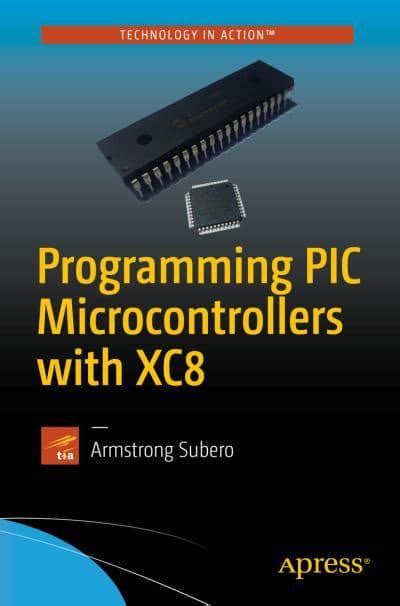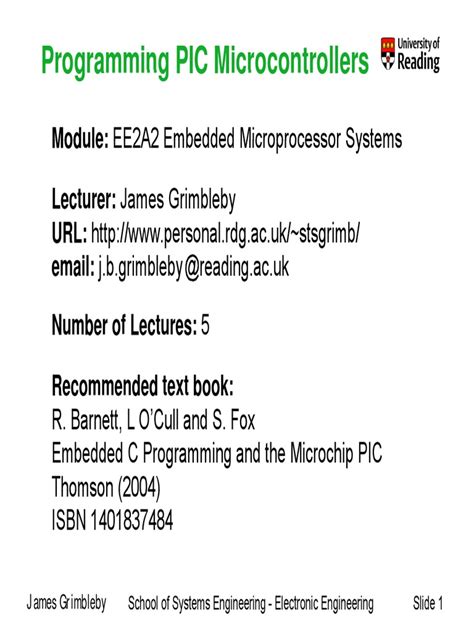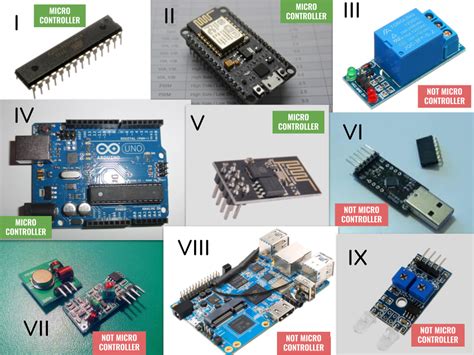Introduction to PIC Microcontrollers and Their Programming Languages
PIC (Peripheral Interface Controller) microcontrollers are a popular choice for embedded systems and electronics projects due to their low cost, wide availability, and ease of use. These microcontrollers, developed by Microchip Technology, come in various families and offer a range of features and capabilities. One of the most important aspects of working with PIC microcontrollers is understanding the programming languages used to develop software for these devices.
In this article, we will explore the different programming languages used for PIC microcontrollers, their features, and their applications. We will also discuss the advantages and disadvantages of each language and provide guidance on choosing the most suitable language for your project.
Table of Contents
- Assembly Language
- C Programming Language
- BASIC Programming Language
- Python Programming Language
- Other High-Level Languages
- Choosing the Right Language for Your Project
- Frequently Asked Questions (FAQ)
1. Assembly Language
Assembly language is a low-level programming language that is specific to a particular processor architecture. In the case of PIC microcontrollers, the assembly language used is called PIC Assembly or MPASM (Microchip Assembly). Assembly language provides direct control over the microcontroller’s hardware and allows for efficient code execution.
Advantages of Assembly Language
- Direct hardware control
- Efficient code execution
- Smaller code size compared to high-level languages
- Suitable for time-critical applications
Disadvantages of Assembly Language
- Steep learning curve
- Less readable and maintainable code
- Longer development time
- Limited portability between different PIC microcontroller families
Example Code: Blinking an LED in PIC Assembly
; Configure PORTB
MOVLW 0x00
TRIS PORTB
; Infinite loop
LOOP:
; Turn on LED
BSF PORTB, 0
CALL DELAY
; Turn off LED
BCF PORTB, 0
CALL DELAY
; Repeat the loop
GOTO LOOP
; Delay subroutine
DELAY:
MOVLW 0xFF
MOVWF COUNT1
DELAY_LOOP:
DECFSZ COUNT1, F
GOTO DELAY_LOOP
RETURN

2. C Programming Language
The C programming language is a high-level language that is widely used for programming PIC microcontrollers. Microchip provides a C compiler called MPLAB XC8, which is specifically designed for 8-bit PIC microcontrollers. C language offers a balance between low-level hardware control and high-level abstraction, making it a popular choice for embedded systems development.
Advantages of C Language
- Easier to learn and maintain compared to assembly language
- Portable code that can be reused across different PIC microcontroller families
- Extensive library support for various peripherals and functions
- Faster development time
Disadvantages of C Language
- Larger code size compared to assembly language
- Slightly reduced performance compared to optimized assembly code
- Requires a C compiler, which may have licensing costs
Example Code: Blinking an LED in C
#include <xc.h>
#define _XTAL_FREQ 4000000
void main() {
TRISB = 0x00; // Configure PORTB as output
while (1) {
// Turn on LED
PORTBbits.RB0 = 1;
__delay_ms(500);
// Turn off LED
PORTBbits.RB0 = 0;
__delay_ms(500);
}
}

3. BASIC Programming Language
BASIC (Beginner’s All-purpose Symbolic Instruction Code) is a high-level programming language that is known for its simplicity and ease of use. Several BASIC dialects, such as PICBASIC and PICBASIC PRO, have been developed specifically for PIC microcontrollers. These dialects provide a simple and intuitive way to program PIC microcontrollers, making them suitable for beginners and rapid prototyping.
Advantages of BASIC Language
- Easy to learn and understand, even for beginners
- Faster development time due to simple syntax
- Built-in commands for common microcontroller functions
- Suitable for small to medium-sized projects
Disadvantages of BASIC Language
- Limited low-level hardware control compared to assembly or C
- Slower execution speed compared to assembly or optimized C code
- Larger code size compared to assembly or C
- Limited support for advanced features and peripherals
Example Code: Blinking an LED in PICBASIC
' Configure PORTB
TRISB = 0
' Infinite loop
DO
' Turn on LED
HIGH PORTB.0
PAUSE 500
' Turn off LED
LOW PORTB.0
PAUSE 500
LOOP

4. Python Programming Language
Python is a high-level, general-purpose programming language known for its simplicity, readability, and extensive library support. While Python is not directly used for programming PIC microcontrollers, there are tools and frameworks that allow the use of Python for PIC development. One such tool is PyMite, a lightweight Python interpreter designed for microcontrollers, including PIC devices.
Advantages of Python Language
- Easy to learn and read, even for beginners
- Extensive library support for various tasks
- Rapid prototyping and development
- Suitable for educational purposes and hobbyist projects
Disadvantages of Python Language
- Requires a Python interpreter or framework, which may have limited support for PIC microcontrollers
- Slower execution speed compared to assembly, C, or BASIC
- Larger code size and memory requirements
- Limited low-level hardware control
Example Code: Blinking an LED in Python (using PyMite)
import pyb
led = pyb.LED(1) # Assuming LED is connected to pin RB0
while True:
led.on()
pyb.delay(500)
led.off()
pyb.delay(500)
5. Other High-Level Languages
In addition to the languages mentioned above, there are other high-level languages that can be used for programming PIC microcontrollers, although their support and usage may be more limited. Some examples include:
- Forth: A stack-based language known for its simplicity and extensibility.
- Lua: A lightweight scripting language that can be embedded into PIC microcontrollers.
- Java: Some PIC microcontrollers support Java-based languages like PICO Java or JavaCard.
These languages offer different features and trade-offs, and their choice depends on the specific requirements of the project and the availability of tools and libraries.
6. Choosing the Right Language for Your Project
When selecting a programming language for your PIC microcontroller project, consider the following factors:
- Project complexity: For simple projects, BASIC or Python may suffice, while more complex projects may require C or assembly language.
- Performance requirements: If high performance and efficient code execution are critical, assembly or optimized C code may be the best choice.
- Development time: High-level languages like C, BASIC, or Python generally offer faster development times compared to assembly language.
- Skill level: If you are a beginner, BASIC or Python may be easier to learn and use, while experienced developers may prefer C or assembly language for more control and efficiency.
- Tool availability: Ensure that the necessary compilers, interpreters, or frameworks are available for the chosen language and are compatible with your specific PIC microcontroller.
Comparison Table: PIC Microcontroller Programming Languages
| Language | Complexity | Performance | Development Time | Skill Level | Tool Availability |
|---|---|---|---|---|---|
| Assembly | High | High | Long | Advanced | Wide |
| C | Medium | Medium-High | Medium | Intermediate | Wide |
| BASIC | Low | Low-Medium | Short | Beginner | Limited |
| Python | Low | Low | Short | Beginner | Limited |
7. Frequently Asked Questions (FAQ)
-
Q: Can I use Arduino language for programming PIC microcontrollers?
A: No, Arduino language (based on C/C++) is specific to Arduino boards and is not directly compatible with PIC microcontrollers. However, you can use C language with MPLAB XC8 compiler for PIC microcontrollers, which shares some similarities with Arduino language. -
Q: Is it necessary to learn assembly language for PIC microcontrollers?
A: While assembly language provides the most control and efficiency, it is not always necessary to learn it. High-level languages like C, BASIC, or Python can be used for most PIC microcontroller projects. However, understanding assembly language concepts can be beneficial for optimizing critical parts of your code. -
Q: Can I use C++ for programming PIC microcontrollers?
A: Microchip provides a C++ compiler called MPLAB XC++, which supports a subset of C++ features for PIC microcontrollers. However, C++ is less commonly used for PIC microcontrollers compared to C language due to its higher complexity and resource requirements. -
Q: Are there any visual programming languages for PIC microcontrollers?
A: There are some visual programming tools available for PIC microcontrollers, such as Flowcode and Microchip’s MPLAB Code Configurator (MCC). These tools allow you to create programs using graphical blocks or diagrams, which are then converted into C or assembly code for the PIC microcontroller. -
Q: Can I use the same programming language for all PIC microcontroller families?
A: While the general syntax and concepts of a programming language remain the same, there may be differences in the specific libraries, functions, and registers used for different PIC microcontroller families. It’s essential to refer to the datasheet and documentation of the specific PIC microcontroller you are using to ensure compatibility and correct usage of the language features.
Conclusion
PIC microcontrollers offer a range of programming languages to suit different project requirements and skill levels. From low-level assembly language to high-level languages like C, BASIC, and Python, developers have the flexibility to choose the most appropriate language for their needs. When selecting a language, consider factors such as project complexity, performance requirements, development time, skill level, and tool availability.
By understanding the features, advantages, and disadvantages of each language, you can make an informed decision and start developing applications for your PIC microcontroller projects. Remember to refer to the manufacturer’s documentation, datasheets, and application notes for specific guidance on using the chosen language with your PIC microcontroller.
Happy coding!
